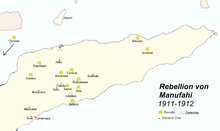East Timorese rebellion of 1910–12

The East Timorese rebellion of 1910–12, sometimes called the Great Rebellion, was a response to the efforts of Portuguese colonial authorities to collect a head tax and enforce the corvée, part of their larger effort to encourage cash crop agriculture and construct modern infrastructure.[1] The countrywide conflict of 1910–12 was the culmination of a series of revolts led by Dom Boaventura, the liurai (chief) of the native kingdom of Manufahi. The first lasted from 1894 to 1901, the second from 1907 to 1908. In 1910 Boaventura led an alliance of local kingdoms in the last and most serious revolt against the Portuguese.[2]
In February 1912 rebels from one kingdom entered the colonial capital of Dili, killing and burning as they went. They looted Government House and decapitated several Portuguese soldiers and officers. In August, the Portuguese brought in troops from Mozambique and a gunboat from Macau to suppress the revolt.[1][3][4]
The revolt cost 3,424 Timorese killed and 12,567 wounded, and 289 Portuguese killed and 600 wounded. After 1912 the Portuguese pacification of East Timor was complete.[1] They also ceased to appoint hereditary liurais and the native states went extinct.[3] The rebellion of 1912 was seminal in creating an East Timorese identity distinct from "Portuguese subject" or just "Timorese".[5]
Notes
- ↑ 1.0 1.1 1.2 Pinto & Jarinde 1997, p. 6.
- ↑ Gunn 2011, p. xxii.
- ↑ 3.0 3.1 Gunn 2011, p. 8.
- ↑ Steenbrink 2007, p. 164.
- ↑ Jannisa 1997, p. 287.
Sources
- Gunn, Geoffrey C. (2011). Historical Dictionary of East Timor. Plymouth: Scarecrow Press.
- Jannisa, Gudmund (1997). The Crocodile's Tears: East Timor in the Making. University of Lund.
- Pinto, Constâncio; Jardine, Matthew (1997). Inside the East Timor Resistance. Toronto: Lorimer.
- Steenbrink, Karel (2007). Catholics in Indonesia: A Documented History, Volume 2 (1903–1942). Koninklijk Instituut voor Taal-, Land- en Volkenkunde.